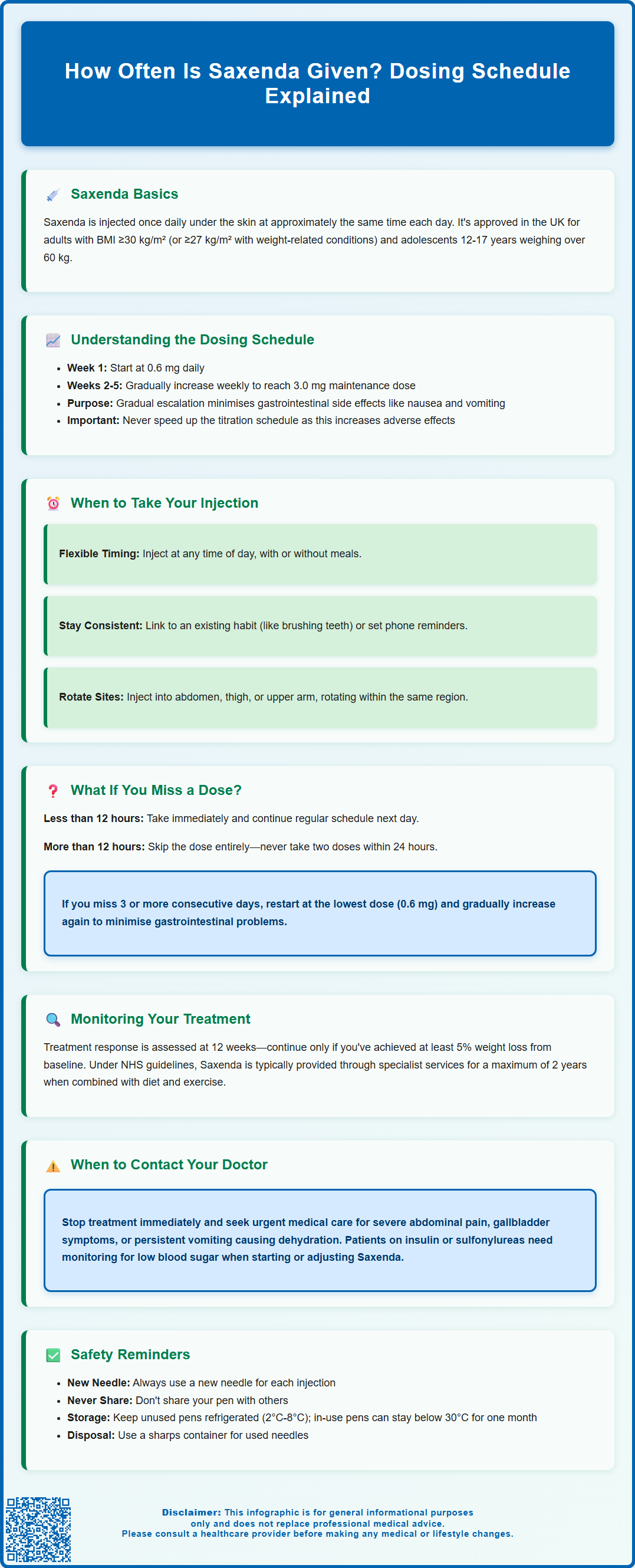Mounjaro®
Dual-agonist support that helps curb appetite, hunger, and cravings to drive substantial, sustained weight loss.
- ~22.5% average body weight loss
- Significant weight reduction
- Improves blood sugar levels
- Clinically proven weight loss

Saxenda (liraglutide 3.0 mg) is administered once daily via subcutaneous injection for weight management in adults and adolescents meeting specific criteria. This GLP-1 receptor agonist is licensed by the MHRA for use alongside a reduced-calorie diet and increased physical activity. The once-daily dosing schedule maintains steady therapeutic levels throughout the day, supporting appetite regulation and metabolic improvements. Treatment begins with a five-week dose escalation from 0.6 mg to the maintenance dose of 3.0 mg daily. Under NICE guidance, Saxenda is typically available through specialist NHS weight management services for a maximum of two years, with formal response assessment required at 12 weeks.
Summary: Saxenda is administered once daily via subcutaneous injection, following a five-week dose escalation from 0.6 mg to the maintenance dose of 3.0 mg.
Saxenda (liraglutide 3.0 mg) is administered once daily via subcutaneous injection, making it a convenient option for weight management when used alongside a reduced-calorie diet and increased physical activity. This once-daily dosing schedule is designed to maintain steady therapeutic levels of the medication throughout the day, supporting appetite regulation and potentially improving metabolic parameters.
The medication is licensed in the UK by the MHRA for adults with a body mass index (BMI) of 30 kg/m² or greater, or 27 kg/m² or greater in the presence of weight-related comorbidities such as type 2 diabetes, hypertension, or dyslipidaemia. It is also licensed for adolescents aged 12 to <18 years weighing >60 kg. The consistent daily administration is crucial for achieving optimal therapeutic outcomes, as irregular dosing may compromise the medication's effectiveness in reducing body weight.
Under NHS guidelines (NICE TA664), Saxenda is typically only available through specialist weight management services and for a maximum treatment duration of 2 years. Patients should aim to inject Saxenda at approximately the same time each day to establish a routine, though the specific time can be adjusted to suit individual lifestyles. It is important to note that Saxenda should never be administered more than once per day, regardless of whether a dose has been missed.
Patients should use a new needle for each injection, never share their pen with others, and dispose of used needles safely in a sharps container. The once-daily regimen differs from some other weight management medications that require multiple daily doses, potentially improving adherence rates.

Saxenda treatment follows a carefully structured dose escalation schedule as outlined in the MHRA/EMC Summary of Product Characteristics (SmPC). This gradual titration is essential for improving tolerability and minimising gastrointestinal side effects whilst allowing the body to adjust to the medication.
The standard titration schedule progresses as follows:
Week 1: 0.6 mg once daily
Week 2: 1.2 mg once daily
Week 3: 1.8 mg once daily
Week 4: 2.4 mg once daily
Week 5 onwards: 3.0 mg once daily (maintenance dose)
This five-week escalation period allows patients to gradually adapt to increasing doses, with each weekly increment doubling or increasing the previous dose. The maintenance dose of 3.0 mg daily represents the therapeutic target for weight management and should be continued for sustained benefit.
If patients experience significant gastrointestinal adverse effects such as nausea, vomiting, or diarrhoea during dose escalation, healthcare professionals may recommend delaying the increase by a few additional days. However, if tolerability issues persist at the 3.0 mg dose after appropriate adjustment time, discontinuation should be considered, as lower doses have not demonstrated the same efficacy for weight management.
It is crucial that patients do not attempt to accelerate the titration schedule, as this significantly increases the risk of adverse effects and may lead to treatment discontinuation. Patients taking insulin or sulfonylureas may have an increased risk of hypoglycaemia when starting Saxenda, and dose adjustments of these medications may be necessary. The pre-filled Saxenda pen is designed to deliver precise doses at each stage, with clear dosing windows to prevent errors.
Saxenda offers considerable flexibility regarding injection timing, allowing patients to integrate treatment into their daily routines without significant disruption. The medication can be administered at any time of day—morning, afternoon, or evening—and does not need to be taken in relation to meals. This flexibility is particularly beneficial for individuals with shift work patterns or irregular schedules.
Whilst the specific time is flexible, consistency is important for establishing a reliable routine that supports adherence. Many patients find it helpful to link their injection to an existing daily habit, such as brushing teeth, having breakfast, or preparing for bed. Setting a daily reminder on a mobile phone can also prove valuable, particularly during the initial weeks of treatment when the routine is being established.
Saxenda is administered via subcutaneous injection only into the abdomen, thigh, or upper arm. Patients should rotate injection sites within the same body region to reduce the risk of lipodystrophy (changes in fat tissue) and injection site reactions. For example, if injecting into the abdomen, alternate between the left and right sides, avoiding the area immediately around the navel and any areas with scars, bruises, or skin abnormalities.
Important safety advice includes using a new needle for each injection, never sharing pens with others, and disposing of used needles in a proper sharps container. Unused pens should be stored in a refrigerator (2°C to 8°C), while in-use pens can be kept below 30°C for up to 1 month. The solution should be clear and colourless; do not use if it appears cloudy or contains particles. The injection should be given at room temperature for improved comfort, and proper injection technique should be demonstrated by a healthcare professional.
Missing an occasional dose of Saxenda does not typically compromise treatment outcomes, provided appropriate action is taken promptly. If a dose is missed and fewer than 12 hours have elapsed since the usual injection time, patients should administer the missed dose as soon as they remember. The following day's injection should then be taken at the regular scheduled time.
However, if more than 12 hours have passed since the missed dose was due, patients should skip that dose entirely and resume their normal schedule with the next planned injection. It is crucial that patients never take two doses within the same 24-hour period or administer a double dose to compensate for the missed injection, as this increases the risk of adverse effects.
If treatment is interrupted for 3 or more consecutive days, patients should restart at the 0.6 mg dose and follow the original dose escalation schedule again, as directed in the Saxenda SmPC. This is important to minimise gastrointestinal side effects that may occur when restarting at a higher dose after an extended break. Patients should contact their healthcare provider before restarting treatment after any extended interruption.
Frequent missed doses may reduce treatment effectiveness and compromise weight loss outcomes. If patients find themselves regularly forgetting doses, they should discuss strategies with their healthcare provider to improve adherence. This might include adjusting the injection time to better suit their routine, using medication reminder apps, or addressing any concerns about side effects or injection technique that may be contributing to non-adherence. Patients taking insulin or sulfonylureas should be particularly vigilant about monitoring blood glucose levels when missing or restarting Saxenda doses.
Saxenda treatment requires ongoing monitoring and assessment to ensure continued appropriateness and effectiveness. NICE guidance (TA664) recommends that weight management interventions should be reviewed regularly, with clear criteria for continuing or discontinuing treatment based on clinical response and tolerability.
Treatment response should be formally assessed at 12 weeks (approximately three months after reaching the maintenance dose). Saxenda should only be continued if patients have achieved at least 5% weight loss from baseline. This threshold represents clinically meaningful weight reduction associated with improvements in cardiovascular risk factors and metabolic parameters. If this target has not been met, discontinuation should be considered, as continued treatment is unlikely to provide sufficient benefit to justify ongoing use and potential adverse effects.
For patients who achieve the 5% weight loss threshold, Saxenda can be continued as part of a comprehensive weight management programme. Under NHS guidelines (NICE TA664), treatment is typically limited to a maximum of 2 years and should be provided within specialist weight management services. Ongoing dietary modification, increased physical activity, and behavioural support remain essential components of successful weight management.
The maintenance dose of 3.0 mg daily typically remains constant throughout treatment. Saxenda should not be used in combination with other GLP-1 receptor agonists. Patients should be advised to stop treatment and seek urgent medical attention if they experience severe, persistent abdominal pain (which could indicate acute pancreatitis), symptoms of gallbladder disease, or persistent vomiting leading to dehydration. Saxenda should be avoided during pregnancy and breastfeeding; patients planning pregnancy should discuss this with their healthcare provider.
Patients are encouraged to report any suspected side effects to the MHRA Yellow Card Scheme (yellowcard.mhra.gov.uk or via the Yellow Card app), which helps monitor the safety of medicines in the UK.
No, Saxenda should never be administered more than once per day. If you miss a dose and more than 12 hours have passed, skip that dose entirely and resume your normal schedule the following day.
Whilst Saxenda can be injected at any time of day, maintaining consistency helps establish a reliable routine that supports adherence. The injection does not need to be taken in relation to meals.
If treatment is interrupted for three or more consecutive days, you must restart at the initial 0.6 mg dose and follow the five-week escalation schedule again to minimise gastrointestinal side effects. Contact your healthcare provider before restarting.
The health-related content published on this site is based on credible scientific sources and is periodically reviewed to ensure accuracy and relevance. Although we aim to reflect the most current medical knowledge, the material is meant for general education and awareness only.
The information on this site is not a substitute for professional medical advice. For any health concerns, please speak with a qualified medical professional. By using this information, you acknowledge responsibility for any decisions made and understand we are not liable for any consequences that may result.
Lorem ipsum dolor sit amet, consectetur adipiscing elit, sed do eiusmod tempor incididunt ut labore et dolore magna aliqua. Ut enim ad minim veniam, quis nostrud exercitation ullamco laboris nisi ut aliquip ex ea commodo consequat. Duis aute irure dolor in reprehenderit in voluptate velit esse cillum dolore eu fugiat nulla pariatur.
Block quote
Ordered list
Unordered list
Bold text
Emphasis
Superscript
Subscript